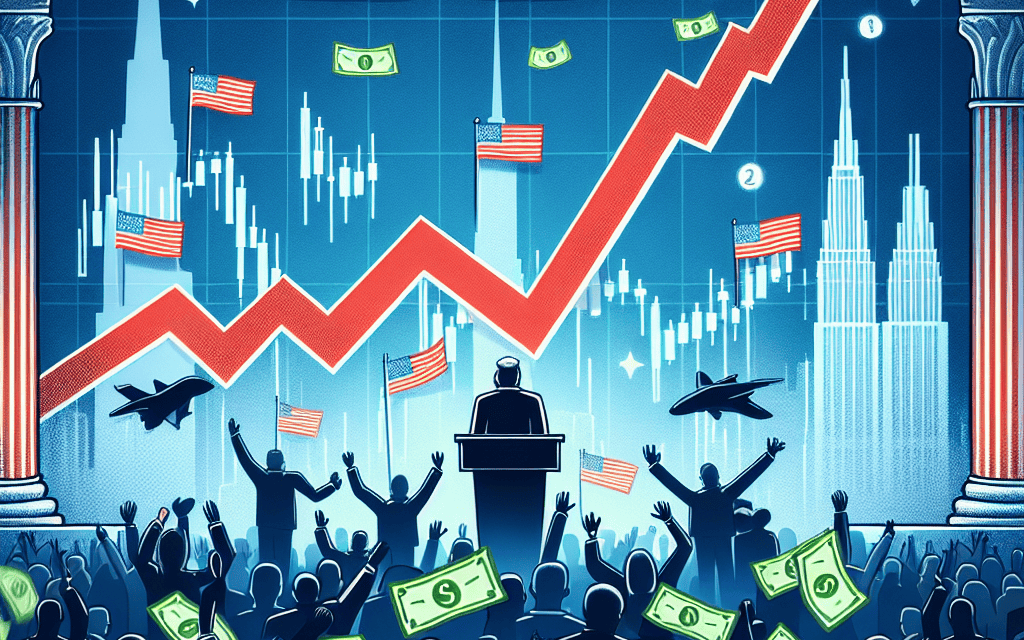“Markets React: Stocks Surge, Bonds Slip in Wake of Trump’s Triumph”
Introduction
Following Donald Trump’s unexpected victory in the 2016 U.S. presidential election, global financial markets experienced significant volatility, with stocks soaring and bonds dipping in response to the political shift. Investors, initially bracing for uncertainty, quickly recalibrated their strategies, anticipating Trump’s pro-business policies, including tax cuts, deregulation, and infrastructure spending, which fueled optimism in the equity markets. This surge in stock prices reflected a renewed confidence in economic growth prospects under the new administration. Conversely, the bond market faced a downturn as expectations of increased government borrowing and potential inflationary pressures led to a sell-off, driving yields higher. This dynamic reaction underscored the complex interplay between political developments and market behavior, highlighting the sensitivity of financial instruments to shifts in policy and investor sentiment.
Impact Of Trump’s Election Victory On Global Stock Markets
The election of Donald Trump as President of the United States sent ripples through global financial markets, with investors reacting swiftly to the unexpected outcome. In the immediate aftermath of the election, stock markets around the world experienced a significant surge, while bond markets saw a notable dip. This reaction can be attributed to a combination of factors, including investor sentiment, anticipated policy changes, and broader economic implications.
Initially, the election result was met with uncertainty, as Trump’s victory defied many pre-election polls and forecasts. However, as investors began to digest the potential implications of his presidency, optimism took hold. The stock market rally was largely driven by expectations of pro-business policies, including tax cuts, deregulation, and increased infrastructure spending. These anticipated measures were seen as catalysts for economic growth, prompting investors to pour money into equities.
In the United States, the Dow Jones Industrial Average and the S&P 500 both reached record highs in the days following the election. This bullish sentiment was mirrored in other major markets, with indices in Europe and Asia also experiencing gains. The financial sector, in particular, benefited from the prospect of deregulation, while industrial and construction stocks were buoyed by the promise of infrastructure investment. Furthermore, the energy sector saw a boost, as Trump’s policies were expected to favor fossil fuel industries.
Conversely, the bond market reacted negatively to Trump’s election victory. The prospect of increased government spending and tax cuts raised concerns about inflation and higher interest rates. As a result, bond prices fell, and yields rose, reflecting the market’s anticipation of tighter monetary policy. This shift in the bond market was not limited to the United States; global bond markets also experienced similar trends, as investors adjusted their portfolios in response to the changing economic landscape.
The impact of Trump’s election victory on global stock markets was not uniform, as different regions and sectors responded in varying ways. Emerging markets, for instance, faced challenges due to concerns about potential trade policies and protectionism. The possibility of renegotiated trade agreements and tariffs created uncertainty for countries heavily reliant on exports to the United States. Consequently, stock markets in some emerging economies experienced volatility and declines.
In addition to regional disparities, sector-specific reactions were also evident. While financials and industrials thrived, technology stocks faced headwinds due to fears of stricter immigration policies and potential trade barriers. These concerns were particularly pronounced for companies with significant global supply chains and reliance on international talent.
As the initial shock of the election result subsided, investors began to focus on the long-term implications of a Trump presidency. While the immediate market reactions were driven by expectations and sentiment, the actual impact of his policies would depend on their implementation and effectiveness. Consequently, market participants remained vigilant, closely monitoring developments in Washington and adjusting their strategies accordingly.
In conclusion, the election of Donald Trump as President of the United States had a profound impact on global stock markets, with stocks soaring and bonds dipping in response to anticipated policy changes. While the initial market reactions were largely positive for equities, the long-term effects would depend on the realization of Trump’s economic agenda. As investors navigated this new landscape, they remained attuned to the evolving political and economic environment, ready to adapt to the challenges and opportunities that lay ahead.
Analyzing The Surge In U.S. Equities Post-Election
In the wake of Donald Trump’s unexpected election victory, financial markets have exhibited a remarkable response, characterized by a significant surge in U.S. equities and a concurrent dip in bond prices. This reaction, while initially surprising to many analysts, can be attributed to a confluence of factors that have collectively influenced investor sentiment and market dynamics. As the dust settles, it becomes imperative to analyze the underlying reasons for this market behavior and its potential implications for the future.
To begin with, the stock market’s robust performance can be largely attributed to investor optimism regarding Trump’s proposed economic policies. His campaign promises of tax cuts, deregulation, and increased infrastructure spending have been perceived as catalysts for economic growth. These policies are expected to stimulate corporate earnings, thereby justifying the bullish sentiment among investors. Furthermore, the anticipation of a more business-friendly environment under Trump’s administration has bolstered confidence in sectors such as finance, energy, and manufacturing, which are poised to benefit from reduced regulatory constraints.
In addition to policy expectations, the market’s reaction can also be understood through the lens of investor psychology. The initial uncertainty surrounding the election outcome had led to heightened volatility in the markets. However, once the results were confirmed, the removal of this uncertainty provided a sense of relief, prompting a rally in equities. This phenomenon, often referred to as a “relief rally,” underscores the importance of clarity and predictability in shaping market behavior.
Conversely, the decline in bond prices can be attributed to rising expectations of inflation and interest rate hikes. Trump’s proposed fiscal policies, particularly increased government spending, are anticipated to drive inflationary pressures. In response, investors have adjusted their portfolios, moving away from bonds, which are more sensitive to inflation and interest rate changes. This shift in asset allocation has resulted in a sell-off in the bond market, leading to a rise in yields.
Moreover, the Federal Reserve’s monetary policy stance plays a crucial role in this context. With the prospect of fiscal stimulus under Trump’s administration, the Fed may be compelled to accelerate its pace of interest rate hikes to prevent the economy from overheating. This expectation has further contributed to the decline in bond prices, as higher interest rates erode the value of existing bonds.
While the immediate market reaction has been positive for equities, it is essential to consider the potential risks and challenges that may arise in the longer term. The implementation of Trump’s policies is contingent upon legislative approval, which may encounter obstacles in Congress. Additionally, the global economic landscape remains fraught with uncertainties, including trade tensions and geopolitical risks, which could impact market stability.
In conclusion, the post-election surge in U.S. equities and the dip in bond prices reflect a complex interplay of policy expectations, investor psychology, and macroeconomic factors. As markets continue to digest the implications of Trump’s victory, it is crucial for investors to remain vigilant and adaptable to evolving conditions. While the current optimism is palpable, a cautious approach is warranted, given the myriad of variables that could influence future market trajectories.
Factors Driving The Decline In Bond Prices After The Election
In the wake of Donald Trump’s unexpected election victory, financial markets have experienced significant shifts, with stocks soaring to new heights while bond prices have notably declined. This divergence in market behavior can be attributed to several interrelated factors that have influenced investor sentiment and expectations. Understanding these factors is crucial for comprehending the broader economic implications of the election outcome.
Firstly, the anticipation of Trump’s economic policies has played a pivotal role in shaping market dynamics. His campaign promises, which emphasized tax cuts, deregulation, and increased infrastructure spending, have fueled optimism among equity investors. These policies are perceived as potentially stimulating economic growth, thereby boosting corporate profits and, consequently, stock prices. However, the same policies have raised concerns about rising inflation and increased government borrowing, which have adversely affected bond markets. As investors anticipate higher inflation, they demand higher yields on bonds to compensate for the eroding purchasing power of future interest payments, leading to a decline in bond prices.
Moreover, the prospect of fiscal expansion under Trump’s administration has led to expectations of a more aggressive monetary policy stance by the Federal Reserve. Investors foresee the possibility of the Fed raising interest rates at a faster pace to counteract inflationary pressures stemming from increased government spending. Higher interest rates make existing bonds with lower yields less attractive, prompting a sell-off in the bond market. This shift in monetary policy expectations has further contributed to the decline in bond prices.
In addition to domestic factors, global market reactions have also influenced bond prices. Trump’s victory has introduced a degree of uncertainty in international trade relations, particularly with key trading partners such as China and Mexico. Concerns about potential trade wars and protectionist measures have led to volatility in global markets, prompting investors to reassess their risk exposure. In such an environment, the traditional safe-haven appeal of U.S. Treasury bonds has been somewhat diminished, as investors seek higher returns in riskier assets like equities.
Furthermore, the election outcome has had implications for currency markets, which in turn have affected bond prices. The U.S. dollar has strengthened significantly following Trump’s victory, driven by expectations of higher interest rates and economic growth. A stronger dollar can negatively impact U.S. exports by making them more expensive for foreign buyers, potentially dampening economic growth. This scenario has led to mixed reactions in the bond market, as investors weigh the potential benefits of a robust domestic economy against the challenges posed by a strong currency.
Lastly, it is important to consider the psychological aspect of market reactions. The initial shock of Trump’s victory led to a rapid reassessment of investment strategies, with many investors moving quickly to adjust their portfolios. This swift reallocation of assets has contributed to the volatility observed in both stock and bond markets. As investors continue to digest the implications of the new administration’s policies, market dynamics are likely to evolve further.
In conclusion, the decline in bond prices following Trump’s election victory can be attributed to a complex interplay of factors, including expectations of fiscal expansion, potential changes in monetary policy, global trade uncertainties, currency fluctuations, and investor psychology. As these elements continue to unfold, they will shape the trajectory of financial markets and the broader economic landscape in the months and years to come.
Investor Sentiment And Market Volatility In The Wake Of Trump’s Win

In the aftermath of Donald Trump’s unexpected election victory, financial markets have exhibited a notable shift, characterized by a surge in stock prices and a concurrent dip in bond values. This reaction underscores the complex interplay between investor sentiment and market volatility, as stakeholders recalibrate their expectations in light of the new political landscape. Initially, the election outcome was met with uncertainty, prompting a brief period of market turbulence. However, as investors began to digest the implications of Trump’s proposed economic policies, a more optimistic sentiment emerged, driving stock markets to new heights.
The rally in equities can be attributed to several factors, chief among them being the anticipation of pro-business policies under the Trump administration. Investors are particularly buoyed by the prospect of corporate tax cuts, deregulation, and increased infrastructure spending, all of which are expected to stimulate economic growth. These policy proposals have instilled confidence in the market, leading to a surge in stock prices, particularly in sectors such as financials, industrials, and energy, which are poised to benefit from a more business-friendly environment.
Conversely, the bond market has experienced a decline, as investors adjust their portfolios in response to the anticipated fiscal policies. The expectation of increased government spending and tax cuts has raised concerns about inflationary pressures, prompting a sell-off in bonds. As a result, bond yields have risen, reflecting the market’s anticipation of higher interest rates in the future. This shift in the bond market highlights the delicate balance investors must maintain between seeking higher returns and managing risk in an evolving economic landscape.
Moreover, the divergence between stocks and bonds underscores the broader theme of market volatility that often accompanies significant political events. While the initial reaction to Trump’s victory was marked by uncertainty, the subsequent rally in equities suggests a recalibration of investor sentiment as market participants gain clarity on the potential economic impact of the new administration’s policies. This dynamic illustrates the inherent volatility in financial markets, where sentiment can shift rapidly in response to changing political and economic conditions.
In addition to domestic factors, global considerations also play a role in shaping investor sentiment. The international community is closely monitoring the implications of Trump’s foreign policy stance, particularly with regard to trade relations and geopolitical alliances. These factors add another layer of complexity to the market’s response, as investors weigh the potential impact on global economic stability and growth.
In conclusion, the market’s reaction to Trump’s election victory highlights the intricate relationship between investor sentiment and market volatility. The surge in stock prices and the dip in bond values reflect a recalibration of expectations as investors navigate the new political and economic landscape. As the Trump administration’s policies begin to take shape, market participants will continue to assess their potential impact, balancing optimism with caution. This ongoing evaluation underscores the dynamic nature of financial markets, where sentiment and volatility are inextricably linked, shaping investment decisions in an ever-changing environment.
Sector-Specific Stock Performance Following The Election
Following the unexpected election victory of Donald Trump, the financial markets have experienced significant fluctuations, with stocks soaring and bonds dipping. This shift in market dynamics has been particularly pronounced in sector-specific stock performance, as investors recalibrate their portfolios in response to anticipated policy changes. The election outcome has sparked optimism in certain sectors, while others face uncertainty, leading to a varied landscape of winners and losers in the stock market.
To begin with, the financial sector has emerged as one of the primary beneficiaries of Trump’s victory. Investors are anticipating a more favorable regulatory environment, with potential rollbacks of stringent financial regulations such as the Dodd-Frank Act. This expectation has fueled a rally in bank stocks, as market participants foresee increased profitability and lending activity. Moreover, the prospect of rising interest rates under a Trump administration has further bolstered the financial sector, as higher rates typically enhance banks’ net interest margins. Consequently, financial stocks have experienced a notable surge, reflecting investor confidence in the sector’s future prospects.
In contrast, the healthcare sector has faced a more complex reaction. While pharmaceutical and biotechnology companies have seen a boost due to the anticipated relaxation of drug pricing regulations, other areas within healthcare remain uncertain. The potential repeal or modification of the Affordable Care Act introduces ambiguity for health insurers and hospital operators, as changes to the healthcare landscape could impact their business models. As a result, the healthcare sector’s performance has been mixed, with some stocks benefiting from policy expectations while others remain cautious amid regulatory uncertainties.
Transitioning to the industrial sector, Trump’s promises of infrastructure spending and tax reforms have invigorated investor sentiment. Companies involved in construction, engineering, and materials have experienced a surge in stock prices, driven by the expectation of increased government investment in infrastructure projects. This anticipated boost in demand for industrial goods and services has led to a positive outlook for the sector, as investors position themselves to capitalize on potential growth opportunities. Furthermore, the prospect of corporate tax cuts has added to the sector’s appeal, as reduced tax burdens could enhance profitability and cash flow for industrial companies.
Meanwhile, the energy sector has also reacted positively to the election outcome. Trump’s pro-energy stance, including support for fossil fuels and deregulation, has buoyed investor confidence in oil and gas companies. The potential for increased domestic energy production and reduced regulatory constraints has led to a rally in energy stocks, as market participants anticipate a more favorable operating environment. However, it is important to note that the renewable energy segment may face challenges, as policy shifts could impact government support and incentives for clean energy initiatives.
In summary, the sector-specific stock performance following Trump’s election victory highlights the diverse reactions across different industries. While the financial, industrial, and energy sectors have generally benefited from policy expectations, the healthcare sector presents a more nuanced picture. As investors continue to assess the implications of the new administration’s policies, market dynamics are likely to evolve, with sector-specific factors playing a crucial role in shaping stock performance. Ultimately, the election outcome has underscored the importance of understanding sector-specific drivers and their potential impact on investment strategies in a rapidly changing economic landscape.
Long-Term Implications Of Trump’s Policies On Financial Markets
The election of Donald Trump as President of the United States has sent ripples through financial markets, with immediate reactions manifesting in soaring stock prices and dipping bond yields. As investors and analysts attempt to decipher the long-term implications of Trump’s policies on financial markets, it is crucial to consider the potential shifts in economic strategies and regulatory frameworks that may unfold. The initial surge in stock markets can be attributed to investor optimism regarding Trump’s pro-business stance, which includes promises of tax cuts, deregulation, and infrastructure spending. These policies are anticipated to stimulate economic growth, thereby boosting corporate profits and, consequently, stock valuations. However, while the short-term market response has been positive, the long-term effects of these policies warrant a more nuanced analysis.
One of the key aspects of Trump’s economic agenda is tax reform, particularly the reduction of corporate tax rates. Lower taxes could increase disposable income for businesses, potentially leading to higher levels of investment and expansion. This, in turn, might drive job creation and consumer spending, further fueling economic growth. However, the challenge lies in balancing tax cuts with fiscal responsibility. If not managed prudently, reduced tax revenues could exacerbate the federal deficit, leading to increased borrowing and potential inflationary pressures. Such a scenario could eventually dampen investor confidence and destabilize financial markets.
In addition to tax reforms, Trump’s emphasis on deregulation is likely to have significant implications for various sectors, particularly finance and energy. By rolling back regulations, the administration aims to reduce compliance costs and encourage innovation. While this may enhance profitability in the short term, it also raises concerns about the potential for increased systemic risk. The financial crisis of 2008 serves as a stark reminder of the dangers posed by insufficient regulatory oversight. Therefore, while deregulation may provide a temporary boost to market performance, it is imperative to consider the potential long-term risks associated with such policies.
Furthermore, Trump’s proposed infrastructure spending is expected to have a stimulative effect on the economy. By investing in the nation’s infrastructure, the administration aims to create jobs and improve productivity. This could lead to increased demand for materials and services, benefiting sectors such as construction and manufacturing. However, the funding of these projects remains a contentious issue. If financed through increased government borrowing, it could lead to higher interest rates, which may negatively impact bond markets and increase the cost of capital for businesses.
Moreover, Trump’s trade policies, characterized by a protectionist stance, could have far-reaching consequences for global financial markets. While the intention is to protect domestic industries and jobs, imposing tariffs and renegotiating trade agreements could lead to retaliatory measures from trading partners. This could disrupt global supply chains, increase costs for businesses, and ultimately affect consumer prices. The uncertainty surrounding trade relations may also lead to increased market volatility, as investors grapple with the potential implications for international commerce.
In conclusion, while Trump’s election victory has initially buoyed stock markets, the long-term implications of his policies on financial markets are complex and multifaceted. While tax cuts, deregulation, and infrastructure spending may provide short-term economic stimulus, the potential risks associated with increased deficits, systemic instability, and trade tensions cannot be overlooked. As such, investors and policymakers must remain vigilant and adaptable, carefully weighing the potential benefits and drawbacks of these policies as they navigate the evolving economic landscape.
Comparing Market Reactions To Previous Presidential Elections
The financial markets have always been sensitive to political events, and presidential elections in the United States are no exception. The recent election victory of Donald Trump has once again highlighted the dynamic interplay between politics and market behavior. In the immediate aftermath of Trump’s win, stock markets experienced a significant surge, while bond markets saw a notable dip. This reaction, while dramatic, is not entirely unprecedented when compared to market responses following previous presidential elections.
Historically, markets have often reacted with volatility during election periods, as investors grapple with the uncertainty of new policies and leadership. For instance, the election of Barack Obama in 2008 occurred amidst the global financial crisis, leading to heightened market anxiety. Initially, stock markets were volatile, but they eventually stabilized as investors gained confidence in the new administration’s economic recovery plans. Similarly, the election of George W. Bush in 2000 was marked by uncertainty due to the contentious nature of the election results, which led to temporary market instability.
In contrast, Trump’s election victory in 2016 was met with an immediate and robust rally in the stock markets. This surge can be attributed to investor optimism regarding Trump’s pro-business stance, promises of tax cuts, and deregulation. The anticipation of these policies fueled expectations of economic growth, prompting a bullish sentiment among investors. However, the bond markets reacted differently, with yields rising and prices falling. This inverse relationship between stocks and bonds is not uncommon, as investors often shift their portfolios in response to changing economic outlooks.
Comparing these reactions to previous elections, it becomes evident that market responses are influenced by the perceived economic policies of the incoming administration. For instance, Ronald Reagan’s election in 1980 also saw a positive response from the stock markets, driven by expectations of tax cuts and deregulation similar to those promised by Trump. Conversely, the election of Bill Clinton in 1992 initially led to market apprehension due to concerns over potential tax increases and healthcare reforms. However, as Clinton’s economic policies unfolded, markets adjusted and eventually thrived during his presidency.
It is important to note that while initial market reactions can be telling, they do not always predict long-term trends. The initial optimism or pessimism can be tempered by subsequent policy implementations and global economic conditions. For example, while Trump’s election initially buoyed the stock markets, the subsequent trade tensions and geopolitical uncertainties introduced new challenges that affected market stability.
In conclusion, the market reactions following Trump’s election victory reflect a pattern observed in previous presidential elections, where investor sentiment is closely tied to anticipated policy changes. The immediate surge in stocks and dip in bonds underscore the market’s sensitivity to political shifts and economic expectations. However, as history has shown, these initial reactions are just one part of a complex narrative that unfolds over the course of a presidency. Investors and analysts alike must remain vigilant, considering both domestic policies and global economic factors, to fully understand the long-term implications of any election on the financial markets.
Q&A
1. **Question:** How did the stock market react immediately after Trump’s election victory?
– **Answer:** The stock market soared, with major indices experiencing significant gains.
2. **Question:** What was the initial reaction of the bond market to Trump’s election victory?
– **Answer:** The bond market saw a dip, with bond prices falling and yields rising.
3. **Question:** Which sectors of the stock market saw the most significant gains following the election?
– **Answer:** Financials, industrials, and healthcare sectors experienced notable gains.
4. **Question:** What were investors’ expectations regarding Trump’s economic policies that influenced market reactions?
– **Answer:** Investors anticipated pro-business policies, tax cuts, deregulation, and increased infrastructure spending.
5. **Question:** How did the currency markets react to Trump’s election victory?
– **Answer:** The U.S. dollar strengthened against other major currencies.
6. **Question:** What was the impact of Trump’s victory on international markets?
– **Answer:** International markets had mixed reactions, with some experiencing volatility and others following the U.S. market’s upward trend.
7. **Question:** How did the market’s reaction to Trump’s victory compare to pre-election predictions?
– **Answer:** The market’s positive reaction was contrary to many pre-election predictions, which anticipated a downturn in the event of a Trump victory.
Conclusion
The election of Donald Trump as President of the United States led to a significant market reaction characterized by a surge in stock prices and a decline in bond prices. Investors anticipated that Trump’s proposed policies, such as tax cuts, deregulation, and increased infrastructure spending, would stimulate economic growth and corporate profits, driving the stock market rally. Conversely, the bond market experienced a dip as expectations of higher inflation and increased government borrowing under Trump’s administration led to concerns about rising interest rates, which negatively impact bond prices. This divergence in market behavior reflects the complex interplay of investor sentiment and economic forecasts in response to political developments.





